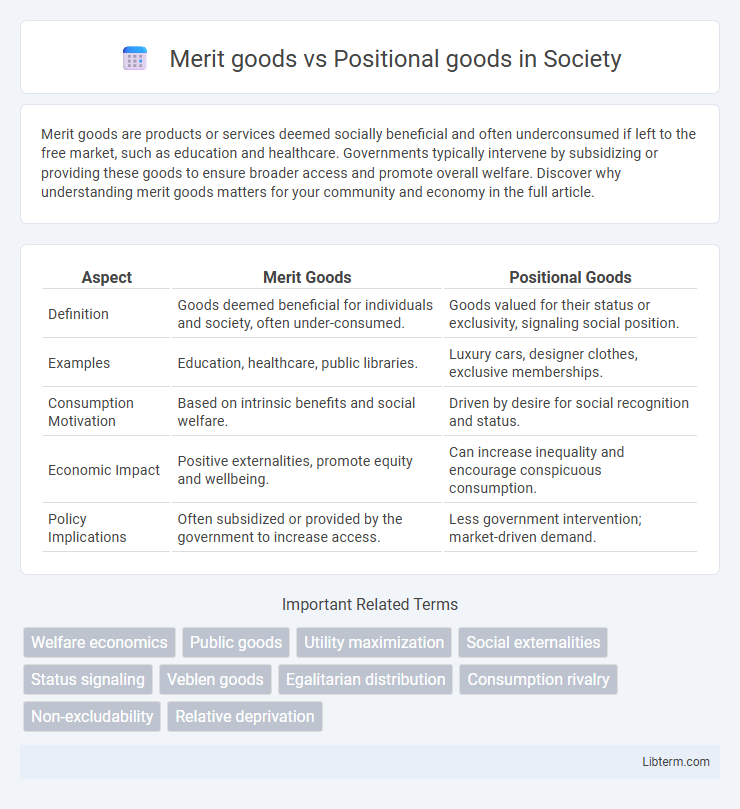Merit goods are products or services deemed socially beneficial and often underconsumed if left to the free market, such as education and healthcare. Governments typically intervene by subsidizing or providing these goods to ensure broader access and promote overall welfare. Discover why understanding merit goods matters for your community and economy in the full article.
Table of Comparison
| Aspect | Merit Goods | Positional Goods |
|---|---|---|
| Definition | Goods deemed beneficial for individuals and society, often under-consumed. | Goods valued for their status or exclusivity, signaling social position. |
| Examples | Education, healthcare, public libraries. | Luxury cars, designer clothes, exclusive memberships. |
| Consumption Motivation | Based on intrinsic benefits and social welfare. | Driven by desire for social recognition and status. |
| Economic Impact | Positive externalities, promote equity and wellbeing. | Can increase inequality and encourage conspicuous consumption. |
| Policy Implications | Often subsidized or provided by the government to increase access. | Less government intervention; market-driven demand. |
Introduction to Merit Goods and Positional Goods
Merit goods are products or services deemed beneficial for individuals and society, often underconsumed if left to private markets, such as education and healthcare. Positional goods derive value primarily from their exclusivity and status signaling, where consumption by one individual reduces its availability to others, like luxury cars and designer clothing. Understanding the distinction highlights policy approaches: merit goods justify public provision or subsidies to correct market failures, while positional goods involve social competition with limited efficiency gains.
Defining Merit Goods: Concepts and Examples
Merit goods are products or services that society values and believes should be accessible to everyone, often provided or subsidized by the government to correct market failures and promote social welfare. Examples of merit goods include education, healthcare, and vaccinations, which generate positive externalities and enhance overall societal well-being. These goods differ from positional goods, which derive value mainly from their exclusivity and status symbol rather than inherent societal benefits.
Understanding Positional Goods: Meaning and Characteristics
Positional goods are items whose value is derived primarily from their status and exclusivity rather than inherent utility, often signaling wealth or social rank. These goods create competitive consumption patterns because their desirability increases as fewer people possess them, exemplifying scarcity and social distinction. Unlike merit goods, which provide intrinsic benefits to society, positional goods mainly satisfy psychological needs for prestige and social comparison.
Economic Rationale Behind Merit Goods
Merit goods, such as healthcare and education, are valued for their positive externalities and the belief that individuals may underconsume them if left to market forces alone, justifying government intervention to ensure wider access. The economic rationale emphasizes correcting market failures by internalizing social benefits and promoting equity and long-term societal welfare. In contrast, positional goods derive value primarily from their status symbol qualities rather than intrinsic social benefits.
The Role of Social Status in Positional Goods
Positional goods derive their value primarily from their ability to confer social status and signal prestige within a community, making consumption a means of differentiating oneself from others. Unlike merit goods, whose benefits are intrinsic and promote overall welfare regardless of social comparison, positional goods emphasize exclusivity and relative ranking in social hierarchies. The competition for positional goods often drives conspicuous consumption, reinforcing social status and influencing individual and collective economic behavior.
Policy Implications: Regulating Merit and Positional Goods
Policy implications for merit goods often involve government intervention through subsidies or public provision to correct underconsumption and promote social welfare, as these goods generate positive externalities. In contrast, regulating positional goods requires addressing status-driven demand and potential inefficiencies, often through taxation or limiting conspicuous consumption to reduce social inequality and resource misallocation. Effective policy design must balance encouraging merit good consumption with managing the competitive dynamics and externalities associated with positional goods.
Impact on Welfare: Merit Goods vs Positional Goods
Merit goods generate positive externalities by providing broad social benefits and improving overall welfare through increased access to education, healthcare, and public services. Positional goods, in contrast, influence welfare primarily through relative status and competition, often leading to consumption that does not enhance collective well-being but exacerbates social inequality. The welfare impact of merit goods is therefore more sustainable and inclusive, while positional goods tend to produce zero-sum outcomes with limited net social gain.
Market Failures and Government Intervention
Merit goods, such as education and healthcare, often suffer from underconsumption due to information asymmetry and external benefits, leading to market failure and government intervention through subsidies or provision. Positional goods, including luxury items and exclusive services, generate market failures by fostering inefficient consumption driven by social status rather than intrinsic value, prompting policymakers to consider taxation or regulation. Government measures address these failures by correcting allocation inefficiencies and promoting equity in resource distribution.
Consumption Patterns and Societal Effects
Merit goods, such as education and healthcare, are consumed for their intrinsic societal benefits and often require government intervention to ensure equitable access, promoting social welfare and reducing inequality. Positional goods, like luxury cars and designer clothes, derive value from their exclusivity and status signaling, driving consumption patterns based on social competition rather than utility. The societal effects differ as merit goods foster collective well-being and human capital development, while positional goods can exacerbate social stratification and encourage wasteful consumption.
Future Trends and Challenges in Managing Merit and Positional Goods
Future trends in managing merit goods involve leveraging advanced data analytics and AI to better identify and target underserved populations, enhancing equitable access to education and healthcare. Positional goods management faces challenges related to escalating social inequality and the need for regulatory frameworks that mitigate status-driven consumption without stifling innovation. Balancing the allocation of resources between merit goods and positional goods requires integrated policy approaches that address both social welfare optimization and competitive social signaling.
Merit goods Infographic

 libterm.com
libterm.com